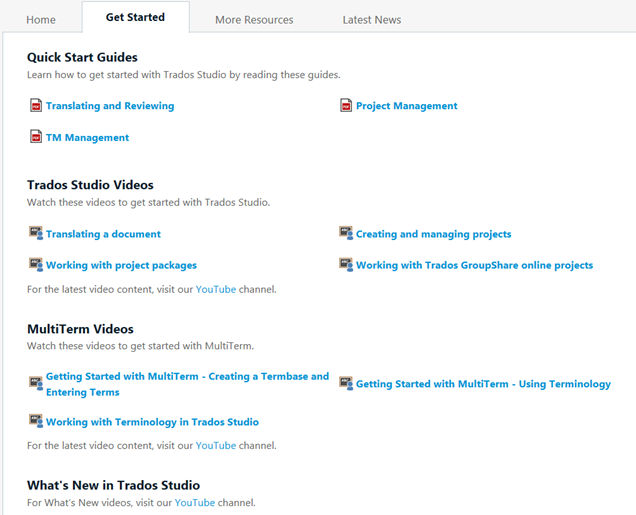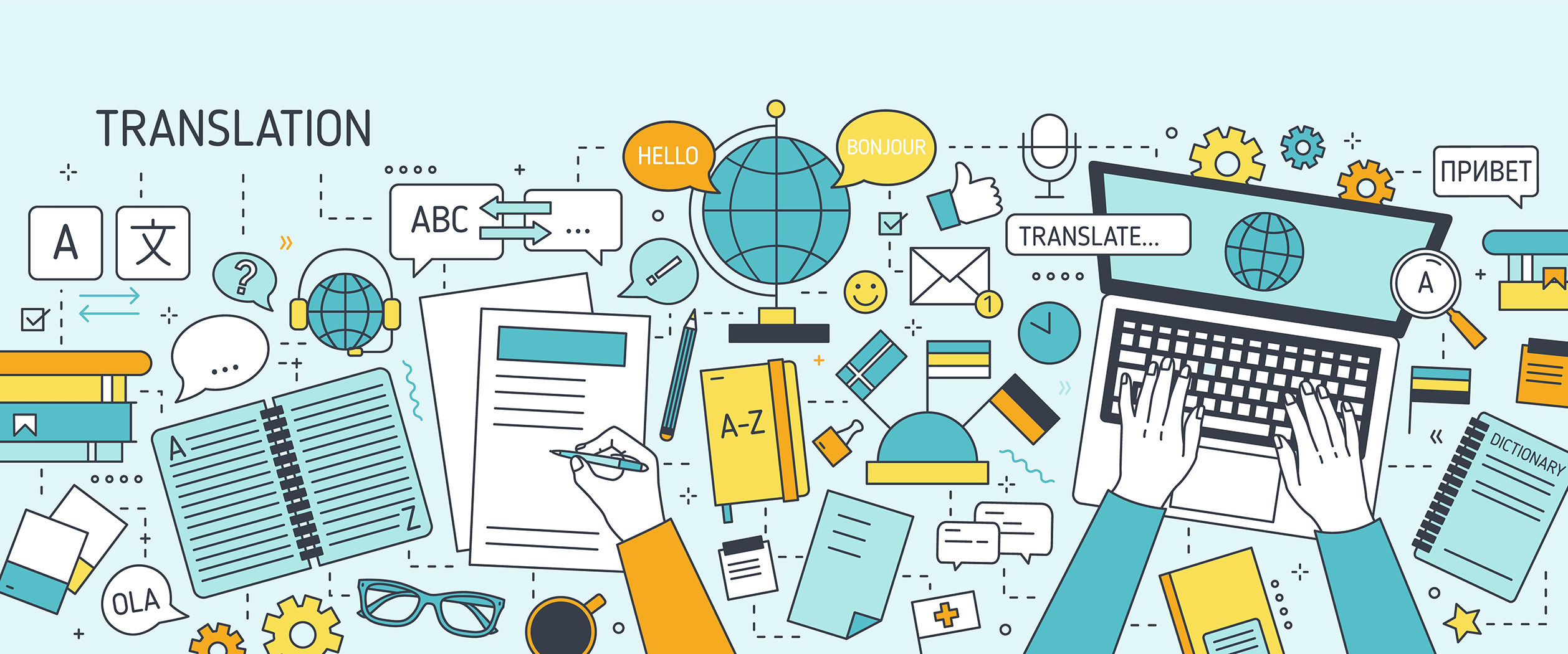I’ve had a few emails recently from some of our wonderful freelance translators asking questions about using Trados Studio for the first time. Whilst there is a wealth of information out there, as a new user (or even a seasoned one) it is difficult to know where to start looking and what you need to be looking for.
With this in mind, I’ve put together a blog post with some helpful tips and resources for anyone looking for guidance when starting to use Trados Studio for the first time.
Help direct from within the software
The first thing to note is that Trados Studio itself contains lots of helpful information. Let’s take a look:
Quick Start PDF Guides and Videos
In the Welcome view..

…, click on the Getting Started tab in the main space in the centre of the screen. The three Quick Start Guides at the top provide a useful starting point as searchable PDFs.

If you prefer to learn visually, then just under these PDFs is a selection of videos that show the most common tasks in Trados Studio (translating a document, creating projects, working with project packages, as well as GroupShare projects). You’ll see there is even a YouTube channel. There is also a separate selection of videos about MultiTerm.
If you cast your eyes upwards to the ribbon, you’ll see a Useful Tips Collection button. This opens up an array of tips about various tasks you can perform using the software, neatly broken down into sections.

Something that I know a lot of freelancers love is the Show Shortcuts button. Click this and you’ll be rewarded with a printable list of all available shortcuts in Trados Studio. Ideal if you want to keep a copy close by to learn the shortcuts you use most.
Note: The Show Shortcuts button is just a printer-friendly list of all available shortcuts. If you want to change or add shortcuts, this is actually done under File > Options > Keyboard shortcuts.
Staying with the ribbon, there is a Help tab here. This is actually available on the ribbon whichever view you’re in (for example: Welcome/Projects/Editor/Translation Memories). From here, there are links to popular sources of help. New users may be particularly interested in:
- Help Topics – where you can access RWS’s online help available in English and several other languages. It’s split into sections to help you locate what you’re looking for more easily.
- Knowledge Base (RWS Support Gateway) – where you can search for help articles and common errors and workarounds.
- RWS Community – where users post questions and other users provide help. It’s split into various forums, for example: Trados Studio to Licensing and Installation. Use the Turn Forum notifications on/off button to receive email digests for a particular forum.
- Product Activation – although not a source of help as such, it’s still interesting to know where to find this. Press this button to activate and deactivate your licences. For example, you may find you use this often if you have one licence which you move between a PC and laptop.
To access the above sources, just click the corresponding button names in Trados Studio itself – the actual URLs behind the buttons are shown above for reference purposes only.
Other useful RWS links
Although there are many more, here is my list from RWS’s website of the ones I think are most beneficial to translators just starting out using Trados Studio:
- How to get started with Trados Studio 2021 – a 45-minute video taking you through everything you need to get started translating your first file in Trados Studio
- Professional translator Emma Goldsmith (see below for her blog) has written a great eBook titled ‘An introduction to translation memory’, answering a variety of questions, expelling some myths and a great section on best practice, not to mention a very handy glossary of key TM (that’s Translation Memory) terms.
- If you’re struggling to know the difference between your QuickPlace and QuickMerge, whether you should be uplifting, or how AnyTM can help you, the Trados Studio 2021 Features Glossary will help you get to grips with some of the internal terminology.
- Although Time savers in Trados Studio 2021 goes a little beyond the basics in Trados Studio, I included it as it contains a really helpful set of tips on how to improve your workflow in the software.
- RWS has put together some frequently asked questions on subjects ranging from system requirements, differences between Starter, Freelance and Professional and new features.
- RWS also runs monthly webinars on a variety of subjects. Sign up to the Newsletter to receive a list of each month’s offering (you can use that link to search through recorded webinars).
Useful blogs
There are lots of blogs out there from translators, and so whilst the below is definitely not an exhaustive list, they are the ones that I think will provide the most help as you start using the software (and well beyond), written by various professionals from the translation industry with fantastic insight and knowledge:
- Paul Filkin – Multifarious – Senior Director Customer Enablement at RWS Group
- Emma Goldsmith – Signs & Symptoms of Translation – a Spanish to English medical translator
- Nora Díaz – Nora Díaz on Translation, Teaching, and Other Stuff – an English-Spanish translator and conference interpreter as well as SDL Trados Studio trainer
- Claire Cox – Lines from a linguist – a French and German into English technical translator
RWS AppStore
Once you’ve found your feet a bit, do be sure to check out the AppStore. This is the place to go to download apps that allow you to enhance the performance and increase the features of Trados Studio. For example, the Wordlight app lets you easily apply highlighting colours like in Word files, whilst the TuToTm app allows you to quickly add single sentences to a TM without a current project/file for translation. There are so many useful apps on here and some that will be helpful straight from the off. You can see my recommendations in my blog posts mentioned below of some key ones for translators.


